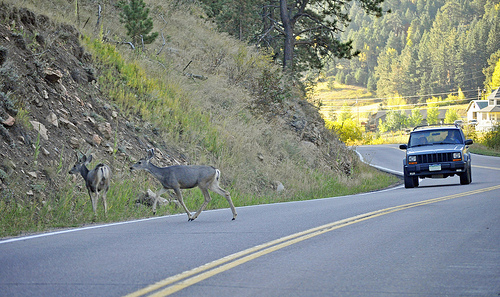How Deer Accidents Affect your Insurance Rates
You’ve always been a safe a driver. You’re heading down the highway at dusk and out the corner of your eye, you get a glimpse something moving and then, BOOM! After you calm down you realize you hit a deer and it really did a number to the front of your car. According to the Insurance Information Institute, car and deer collisions cost $4 billion a year. Iowa is ranked third in the nation for the likelihood of a deer collision.
Which insurance coverage pays for deer collisions?
Your auto insurance’s comprehensive coverage will pay for your car’s property damage caused by a collision with a deer or animal. Comprehensive coverage is sometimes called, “Other than Collision.” This is the same coverage that pays for damage to your car by many natural causes such as wind, fire, hail, flood or falling objects like a tree branch downed in a storm. Deer strikes are not considered a collision by insurance because the animal usually runs into your vehicle.
Comprehensive insurance claims are considered not at-fault. Therefore insurance companies don’t surcharge for collisions with a deer. Your deductible would apply, although some insureds maintain a slightly lower deductible on their comprehensive coverage than on their collision coverage. The reasoning behind this practice is some are willing to bear more of the risk for an accident they caused if they feel they are a relatively safe driver. The higher your deducible, the lower your premium cost.
Brake – don’t swerve
I had a customer who reported a deer related claim. Several deer had run onto the roadway at once and her instinct was to avoid them. She quickly jerked the steering wheel, putting the car into the ditch and damaging the car. The claims adjuster asked if she hit any of the deer. She said she wasn’t sure since it happened so fast. The adjuster asked if there was any physical evidence of the deer on her car such as blood or fur. There wasn’t any and subsequently the claim was ruled a collision, an at-fault accident. That triggered a premium surcharge and a loss of the safe driving discount, a double blow to the pocketbook!
No one deliberately wants to see an animal get harmed. However much more serious crashes can occur when you quickly serve out of your lane into the path of another car or object. Instead, stay in your lane and brake firmly if you see a deer coming into your path. Be on the lookout for deer especially at dawn and dusk when deer are most active.
Deer Season in Iowa
The regular shotgun deer season is roughly Dec. 5th through 20th this year. As deer are flushed out of their habitat they can end up running across roads and highways. Mating season or “the rut” also occurs in the fall of the year, typically late October to early November in Iowa. Be particularly vigilant and avoid an expensive encounter with a deer this season!
Learn More: Understanding your Auto Insurance
photo credit: Deer crossing the road
Posted in: Driving Tips, Insurance Tips
Leave a Comment (0) →

Practice Iowa Winter Weather Driving Skills
Posted by Ed Faber on November 28, 2015Driving safely in Iowa’s winters takes practice
Save on your Auto Insurance with the Three P’s
Winter weather is upon us and once again we need to relearn how to drive on snow and ice. Drivers are more likely to get into an accident during the first snowfall of the year compared to all other snow days, according to a University of Michigan study. The National Highway Traffic Safety Administration advises the three P’s of safe winter driving:
A good way to prepare is to practice safe winter driving. We all may be guilty of complaining about other drivers who “forget how to drive” on ice and snow. Don’t be that driver! In the daylight, rehearse maneuvers slowly on snow in an empty lot. Remember to steer into a skid. If your car has anti-lock brakes, stomp down firmly on the brake. Anti-lock brakes automatically pumps the brake to prevent them from locking up and acting like a sled runner. If you don’t have anti-lock brakes you need to pump the brake manually up and down to slow the car without going into a full slide.
Maintain your car. Check the fluids, test the battery and check tires for wear and proper inflation. Keep an emergency road kit in your car along with extra clothing, blankets and first aid.
Remember stopping distances are longer on slick roadways. You can test the road conditions by braking well before you need to see how your car reacts and adjust stopping distances accordingly. For Iowa road conditions reports, go to: www.511ia.org. Call 511 or 800-288-1047 for road reports from the Iowa DOT.
Protect yourself by buckling up before putting your vehicle into gear. Sit at least 10” back from an airbag. Use child safety seats and make sure they are properly installed. Children are safer in the rear seat.
Prevent crashes by staying, getting plenty of sleep and avoiding drugs or alcohol. alert, avoid distractions while driving such as texting, adjusting the radio or GPS. Above all be a courteous and patient driver. That’s easier said than done so practice patience everyday!
Learn more about Iowa auto insurance coverage.
Related: How to Save Money on your Auto Insurance
photo credit: Slippery Driving via photopin (license)
Posted in: Commentary, Driving Tips
Leave a Comment (0) →